-
Content Count
343 -
Joined
-
Last visited
-
Days Won
4
Posts posted by shineworld
-
-
A silly solution was to place DelphiVCL in a thread, but I don't know if it is the better way...
Code presents a lot of global values, is just a test in waiting for a better idea from Python/DelphiVCL gurus 🙂
import time import asyncio import logging import threading from asyncua import Client from delphivcl import * # == opc ua client settings == OPC_UA_SERVER_URL = "opc.tcp://localhost:4840/" OPC_UA_SERVER_URI = "https://someone.com/opc-ua/server" OPC_UA_ASYNC_SLEEP_TIME = 0.01 # == deveopment settings == DEBUG_LEVEL = logging.CRITICAL # avoid any log not critical DEBUG_ENABLED = False # creates a logger logger = logging.getLogger(__name__) app = None opcua_main_exit = False program_position = [] async def opcua_main(form): global opcua_main_exit global program_position async with Client(url=OPC_UA_SERVER_URL) as client: # gets namespace index idx = await client.get_namespace_index(OPC_UA_SERVER_URI) # gets program position node program_position_node = client.get_node("ns=2;s=CNC.ProgramPosition") while not opcua_main_exit: await asyncio.sleep(OPC_UA_ASYNC_SLEEP_TIME) # reads program positions value = await program_position_node.read_value() program_position = list(value) class DesktopView(Form): def __init__(self, owner): self.SetProps(Caption = "Welcome") # creates labels for program position axes values self.label_x = Label(self) self.label_x.SetProps(Parent=self, Top=40, Left=20) self.label_x.Caption = 'Z : {:15.3f}'.format(0.0) self.label_y = Label(self) self.label_y.SetProps(Parent=self, Top=60, Left=20) self.label_y.Caption = 'Y : {:15.3f}'.format(0.0) self.label_z = Label(self) self.label_z.SetProps(Parent=self, Top=80, Left=20) self.label_z.Caption = 'X : {:15.3f}'.format(0.0) # create and set update timer self.tmrUpdate = Timer(self) self.tmrUpdate.Enabled = False self.tmrUpdate.Interval = 1 self.tmrUpdate.OnTimer = self.__on_timer_update self.tmrUpdate.Enabled = True def __on_timer_update(self, sender): global program_position if len(program_position) == 6: self.label_x.Caption = str(program_position[0]) self.label_y.Caption = str(program_position[1]) self.label_z.Caption = str(program_position[2]) def app_main(): # initializes GUI Application Application.Initialize() Application.Title = "OPC UA Client Demo" # creates main application form app = DesktopView(Application) app.Show() FreeConsole() # enters in vcl main loop Application.Run() global opcua_main_exit opcua_main_exit = True # frees main application form app.Destroy() if __name__ == "__main__": app_thread = threading.Thread(target=app_main) app_thread.start() logging.basicConfig(level=DEBUG_LEVEL) asyncio.run(opcua_main(app))
-
Hi all,
it is possible to use the asyncio with a DelphiVCL ui-based program?
I've implemented an asyncua Client to get data from an OPC UA Server.
Here is a simple program that prints some values collected from an OPC UA server."""CNC OPC UA Client.""" #------------------------------------------------------------------------------- # Name: cnc_opcua_client # # Purpose: CNC OPC UA Client # # Note Checked with Python 3.11.3 # # Coding Style https://www.python.org/dev/peps/pep-0008/ #------------------------------------------------------------------------------- import time import asyncio import logging from asyncua import Client # == opc ua client settings == OPC_UA_SERVER_URL = "opc.tcp://localhost:4840/" OPC_UA_SERVER_URI = "https://www.someone.com/opc-ua/server" OPC_UA_ASYNC_SLEEP_TIME = 0.01 # == deveopment settings == DEBUG_LEVEL = logging.CRITICAL # avoid any log not critical DEBUG_ENABLED = False # creates a logger logger = logging.getLogger(__name__) async def main(): """Main entry point.""" # creats opc ua client in with-exception-handled block async with Client(url=OPC_UA_SERVER_URL) as client: # gets namespace index idx = await client.get_namespace_index(OPC_UA_SERVER_URI) # gets program position node program_position_node = client.get_node("ns=2;s=CNC.ProgramPosition") # server updating loop while True: # does nothing, just process relax await asyncio.sleep(OPC_UA_ASYNC_SLEEP_TIME) # reads and prints program positions value = await program_position_node.read_value() print('X:{:10.3f}, Y:{:10.3f}, Z:{:10.3f}'. format(value[0], value[1], value[2])) # checks if this module is running as the main program if __name__ == "__main__": logging.basicConfig(level=DEBUG_LEVEL) asyncio.run(main(), debug=DEBUG_ENABLED)
Getting:
*** Remote Interpreter Reinitialized *** X: 51.206, Y: 0.000, Z: 0.000 X: 51.206, Y: 0.000, Z: 0.000 X: 51.206, Y: 0.000, Z: 0.000 X: 51.206, Y: 0.000, Z: 0.000
At this point I would like to create a fashioned UI using DelphiVCL, but I'm unable to understand where to place the
asyncio.run(main(), debug=DEBUG_ENABLED)because to get DelphiVCL UI the main loop is already done by Application.Run() call:
# initializes GUI ApplicationApplication.Initialize()Application.Title = "OPC UA Client Demo"
# creates main application formapp = DesktopView(Application)app.Show()FreeConsole()
# enters in vcl main loopApplication.Run()
# frees main application formapp.Destroy()
Thanks in advance for any suggestion.
Best Regards
Silverio -
4 hours ago, pyscripter said:Let's not start language wars in this thread, which is about a significant development in Python 12 and how take advantage of it using P4D. P4D is about combining the strengths of python and Delphi, not choosing one versus the other.
This was my case, in which the main UI and image analysis, with OpenCV, was managed with Python + DelphiVCL, and faster IP Camera commands and frames receiving were managed by a Delphi P4D, in this case, D4P, module using native Threads of Delphi.
The attempt to manage frame acquisition via socket with python threads failed miserably.
The combo was winning !!!
I the future of Python I will be happy to have more power on threads and cores. -
I am slightly confused about which repository of python4delphi
is most correct to use to integrate Python into my Delphi applications.
To date, I know of two repositories on which constant work is visible:
- https://github.com/pyscripter/python4delphi
- https://github.com/Embarcadero/python4delphi
Comparing them it seems that they are managed by different people, but both make fixes and new features with quite a lot of activity, so they are both "alive."
Does anyone know how this is organized and which one is preferable to use?
Thanks in advance for the answers. -
I've tried to move from sslvSSLv23 to sslvTLSv1_2 as in the test code below but FileZilla says:
2023-09-30 10:39:20 11520 1 Status: Connecting to 127.0.0.1:21...
2023-09-30 10:39:20 11520 1 Status: Connection established, waiting for welcome message...
and
> openssl s_client -starttls ftp -connect 192.168.0.27:21
says:
P:\>openssl s_client -starttls ftp -connect 192.168.0.27:21
CONNECTED(00000178)
... infinite wait without do nothing..
{** * TAKE CARE * ========= * This unit is purely for study purposes in which to learn the basics about building and testing an FTP server with * various levels of security. Server activation is in class constructor, and server properties manually placed before * its activation. On final class will be implemented a Start & Stop method to control it, with a property to get the * current state. The server settings will be placed in properties to be set before to activate the server. * **} unit osFTPServer; interface uses System.Classes, IdCTypes, IdContext, IdComponent, IdFTPList, IdFTPServer, IdFTPListOutput, IdSSLOpenSSL, IdSSLOpenSSLHeaders; type TFTPServerSecurityPolicy = ( fssp_None, fssp_sslvSSLv23, fssp_sslvTLSv1_2 ); TFTPServer = class private FCertificatesPath: string; FFTPServer: TIdFTPServer; FIOHandlerSSLOpenSLL: TIdServerIOHandlerSSLOpenSSL; FOpenSSLDLLPath: string; FPassword: string; FRootPath: string; FSecurityPolicy: TFTPServerSecurityPolicy; FUsername: string; private procedure ServerChangeDirectory(ASender: TIdFTPServerContext; var VDirectory: TIdFTPFileName); procedure ServerConnect(AContext: TIdContext); procedure ServerDeleteFile(ASender: TIdFTPServerContext; const APathName: TIdFTPFileName); procedure ServerDisconnect(AContext: TIdContext); procedure ServerListDirectory(ASender: TIdFTPServerContext; const APath: TIdFTPFileName; ADirectoryListing: TIdFTPListOutput; const ACmd: string; const ASwitches: string); procedure ServerMakeDirectory(ASender: TIdFTPServerContext; var VDirectory: TIdFTPFileName); procedure ServerRemoveDirectory(ASender: TIdFTPServerContext; var VDirectory: TIdFTPFileName); procedure ServerStoreFile(ASender: TIdFTPServerContext; const AFileName: TIdFTPFileName; AAppend: Boolean; var VStream: TStream); procedure ServerUserLogin(ASender: TIdFTPServerContext; const AUsername, APassword: string; var VAuthenticated: Boolean); procedure SSLGetPassword(var Password: string); procedure SSLGetPasswordEx(ASender: TObject; var VPassword: string; const AIsWrite: Boolean); procedure SSLStatus(ASender: TObject; const AStatus: TIdStatus; const AStatusText: string); procedure SSLStatusInfo(const AMsg: string); procedure SSLStatusInfoEx(ASender: TObject; const AsslSocket: PSSL; const AWhere, Aret: TIdC_INT; const AType, AMsg: string); private function FixPath(const APath: string): string; public constructor Create; destructor Destroy; override; end; implementation uses System.IOUtils, System.SysUtils, IdSSL, IdExplicitTLSClientServerBase; function FixTailPathDelimiter(const S: string): string; begin Result := IncludeTrailingPathDelimiter(ExcludeTrailingPathDelimiter(S)); end; procedure SafeFreeAndNil(var Obj); var Temp: TObject; begin try Temp := TObject(Obj); if Temp <> nil then begin Pointer(Obj) := nil; Temp.Free; end; except end; end; { TFTPServer } constructor TFTPServer.Create; begin inherited; // inits default members values FCertificatesPath := ''; FFTPServer := nil; FIOHandlerSSLOpenSLL := nil; FOpenSSLDLLPath := ''; FPassword := ''; FRootPath := ''; FSecurityPolicy := fssp_None; FUsername := ''; // TEMPORARY: manually set FTP settings (WILL BE PLACED ON PROPERTIES) FCertificatesPath := 'D:\x\develop\qem\rosetta_cnc_1\certificates\ftpserver\'; FOpenSSLDLLPath := 'D:\x\develop\qem\rosetta_cnc_1\openssl.64'; FPassword := '12345'; FRootPath := 'D:\x\develop\qem\rosetta_cnc_1\certificates\'; //FSecurityPolicy := fssp_sslvSSLv23; FSecurityPolicy := fssp_sslvTLSv1_2; FUsername := 'user'; // TEMPORARY: creates, sets and start FTP server IdOpenSSLSetLibPath(FOpenSSLDLLPath); FFTPServer := TIdFTPServer.Create; FFTPServer.DefaultPort := 21; FFTPServer.OnChangeDirectory := ServerChangeDirectory; FFTPServer.OnConnect := ServerConnect; FFTPServer.OnDeleteFile := ServerDeleteFile; FFTPServer.OnDisconnect := ServerDisconnect; FFTPServer.OnListDirectory := ServerListDirectory; FFTPServer.OnMakeDirectory := ServerMakeDirectory; FFTPServer.OnRemoveDirectory := ServerRemoveDirectory; FFTPServer.OnStoreFile := ServerStoreFile; FFTPServer.OnUserLogin := ServerUserLogin; case FSecurityPolicy of fssp_None: ; fssp_sslvSSLv23: begin FIOHandlerSSLOpenSLL := TIdServerIOHandlerSSLOpenSSL.Create(nil); FIOHandlerSSLOpenSLL.OnStatus := SSLStatus; FIOHandlerSSLOpenSLL.OnStatusInfo := SSLStatusInfo; FIOHandlerSSLOpenSLL.OnStatusInfoEx := SSLStatusInfoEx; FIOHandlerSSLOpenSLL.OnGetPassword := SSLGetPassword; FIOHandlerSSLOpenSLL.OnGetPasswordEx := SSLGetPasswordEx; FIOHandlerSSLOpenSLL.SSLOptions.Mode := sslmServer; FIOHandlerSSLOpenSLL.SSLOptions.Method := sslvSSLv23; FIOHandlerSSLOpenSLL.SSLOptions.CertFile := FCertificatesPath + 'server-cert.pem'; FIOHandlerSSLOpenSLL.SSLOptions.KeyFile := FCertificatesPath + 'server-key.pem'; FIOHandlerSSLOpenSLL.SSLOptions.RootCertFile := FCertificatesPath + 'root-cert.pem'; FIOHandlerSSLOpenSLL.SSLOptions.RootCertFile := ''; FFTPServer.IOHandler := FIOHandlerSSLOpenSLL; FFTPServer.UseTLS := utUseRequireTLS; end; fssp_sslvTLSv1_2: begin {.DEFINE USES_DHPARAM} // NOTE: to use this create a dhparam.pem file with openssl in this way openssl dhparam -out dhparam.pem 4096 FIOHandlerSSLOpenSLL := TIdServerIOHandlerSSLOpenSSL.Create(nil); FIOHandlerSSLOpenSLL.OnStatus := SSLStatus; FIOHandlerSSLOpenSLL.OnStatusInfo := SSLStatusInfo; FIOHandlerSSLOpenSLL.OnStatusInfoEx := SSLStatusInfoEx; FIOHandlerSSLOpenSLL.OnGetPassword := SSLGetPassword; FIOHandlerSSLOpenSLL.OnGetPasswordEx := SSLGetPasswordEx; FIOHandlerSSLOpenSLL.SSLOptions.Mode := sslmServer; FIOHandlerSSLOpenSLL.SSLOptions.Method := sslvTLSv1_2; {$IFDEF USES_DHPARAM} FIOHandlerSSLOpenSLL.SSLOptions.CipherList := ( '!EXPORT:!LOW:!aNULL:!eNULL:!RC4:!ADK:!3DES:!DES:!MD5:!PSK:!SRP:!CAMELLIA' + ':ECDHE-RSA-AES128-GCM-SHA256' + ':ECDHE-RSA-AES256-GCM-SHA384' + ':ECDHE-RSA-CHACHA20-POLY1305' + ':DHE-RSA-AES128-GCM-SHA256' + ':DHE-RSA-AES256-GCM-SHA384' + '' ); FIOHandlerSSLOpenSLL.SSLOptions.DHParamsFile := FCertificatesPath + 'dhparam.pem'; {$ELSE} FIOHandlerSSLOpenSLL.SSLOptions.CipherList := ( '!EXPORT:!LOW:!aNULL:!eNULL:!RC4:!ADK:!3DES:!DES:!MD5:!PSK:!SRP:!CAMELLIA' + ':ECDHE-RSA-AES128-GCM-SHA256' + ':ECDHE-RSA-AES256-GCM-SHA384' + ':ECDHE-RSA-CHACHA20-POLY1305' ); FIOHandlerSSLOpenSLL.SSLOptions.DHParamsFile := ''; {$ENDIF} FIOHandlerSSLOpenSLL.SSLOptions.CertFile := FCertificatesPath + 'server-cert.pem'; FIOHandlerSSLOpenSLL.SSLOptions.KeyFile := FCertificatesPath + 'server-key.pem'; FIOHandlerSSLOpenSLL.SSLOptions.RootCertFile := FCertificatesPath + 'root-cert.pem'; FIOHandlerSSLOpenSLL.SSLOptions.RootCertFile := ''; FFTPServer.IOHandler := FIOHandlerSSLOpenSLL; FFTPServer.UseTLS := utUseRequireTLS; end; end; // sets passive boundary ports range to permit more than one file operation (eg: client multiple copy file to server) FFTPServer.PASVBoundPortMin := 60000; FFTPServer.PASVBoundPortMax := 65535; FFTPServer.Active := True; end; destructor TFTPServer.Destroy; begin //### does jobs to deactivate server before to free it!!! // frees objects SafeFreeAndNil(FFTPServer); SafeFreeAndNil(FIOHandlerSSLOpenSLL); inherited; end; function TFTPServer.FixPath(const APath: string): string; begin Result := StringReplace(APath, '/', '\', [rfReplaceAll]); Result := StringReplace(Result, '\\', '\', [rfReplaceAll]); end; procedure TFTPServer.ServerChangeDirectory(ASender: TIdFTPServerContext; var VDirectory: TIdFTPFileName); begin //### end; procedure TFTPServer.ServerConnect(AContext: TIdContext); begin case FSecurityPolicy of fssp_None: ; fssp_sslvSSLv23: ; fssp_sslvTLSv1_2: begin // PassThroung must be set to False for it to handle SSL/TLS functionality if AContext.Connection.IOHandler is TIdSSLIOHandlerSocketBase then TIdSSLIOHandlerSocketBase(AContext.Connection.IOHandler).PassThrough := False; end; end; end; procedure TFTPServer.ServerDeleteFile(ASender: TIdFTPServerContext; const APathName: TIdFTPFileName); begin DeleteFile(FixPath(FRootPath + ASender.CurrentDir + '\' + APathname)); end; procedure TFTPServer.ServerDisconnect(AContext: TIdContext); begin //### end; procedure TFTPServer.ServerListDirectory(ASender: TIdFTPServerContext; const APath: TIdFTPFileName; ADirectoryListing: TIdFTPListOutput; const ACmd, ASwitches: string); var Status: Integer; SearchRec: TSearchRec; Item: TIdFTPListOutputItem; begin try ADirectoryListing.DirFormat := doWin32; ADirectoryListing.Switches := ASwitches; {$WARN SYMBOL_PLATFORM OFF} Status := FindFirst(FixPath(FRootPath + FixTailPathDelimiter(APath) + '*.*'), faAnyFile - faHidden - faSysFile, SearchRec); {$WARN SYMBOL_PLATFORM ON} try while Status = 0 do begin Item := ADirectoryListing.Add; if SearchRec.Attr and faDirectory = 0 then Item.ItemType := ditFile else Item.ItemType := ditDirectory; Item.FileName := SearchRec.Name; Item.Size := SearchRec.Size; Item.ModifiedDate := SearchRec.TimeStamp; Status := FindNext(SearchRec); end; finally FindClose(SearchRec); end; except end; end; procedure TFTPServer.ServerMakeDirectory(ASender: TIdFTPServerContext; var VDirectory: TIdFTPFileName); begin try ForceDirectories(FixPath(FRootPath + VDirectory)); except end; end; procedure TFTPServer.ServerRemoveDirectory(ASender: TIdFTPServerContext; var VDirectory: TIdFTPFileName); begin try TDirectory.Delete(FixPath(FRootPath + VDirectory), True); except end; end; procedure TFTPServer.ServerStoreFile(ASender: TIdFTPServerContext; const AFileName: TIdFTPFileName; AAppend: Boolean; var VStream: TStream); var Path: string; begin // extracts path and forces creation if does not exits Path := ExtractFilePath(FixPath(FRootPath + AFilename)); if not DirectoryExists(Path) then ForceDirectories(Path); // opens a file stream for cration or append if not AAppend then VStream := TFileStream.Create(FixPath(FRootPath + AFilename), fmCreate) else VStream := TFileStream.Create(FixPath(FRootPath + AFilename), fmOpenWrite) end; procedure TFTPServer.ServerUserLogin(ASender: TIdFTPServerContext; const AUsername, APassword: string; var VAuthenticated: Boolean); begin // checks user and password validity case FSecurityPolicy of fssp_None: begin VAuthenticated := True; end; fssp_sslvSSLv23: begin VAuthenticated := ( (FUsername = Trim(AUserName)) and (FPassword = Trim(APassword)) ); end; fssp_sslvTLSv1_2: begin VAuthenticated := ( (FUsername = Trim(AUserName)) and (FPassword = Trim(APassword)) ); end; end; end; procedure TFTPServer.SSLGetPassword(var Password: string); begin //### Password := FPassword; end; procedure TFTPServer.SSLGetPasswordEx(ASender: TObject; var VPassword: string; const AIsWrite: Boolean); begin //### end; procedure TFTPServer.SSLStatus(ASender: TObject; const AStatus: TIdStatus; const AStatusText: string); begin //### end; procedure TFTPServer.SSLStatusInfo(const AMsg: string); begin //### end; procedure TFTPServer.SSLStatusInfoEx(ASender: TObject; const AsslSocket: PSSL; const AWhere, Aret: TIdC_INT; const AType, AMsg: string); begin //### end; end.Have you any suggestions?
Thanks in advance for any suggestions. -
Being really ignorant of security I put a few breakpoints in the sources and followed step by step changing the options from way to way.
Something seems to be working now...
unit osFTPServer; interface uses IdCTypes, IdContext, IdComponent, IdFTPList, IdFTPServer, IdFTPListOutput, IdSSLOpenSSL, IdSSLOpenSSLHeaders; type TFTPServer = class private FFTPServer: TIdFTPServer; FIOHandlerSSLOpenSLL: TIdServerIOHandlerSSLOpenSSL; private procedure ServerConnect(AContext: TIdContext); procedure ServerDisconnect(AContext: TIdContext); procedure ServerUserLogin(ASender: TIdFTPServerContext; const AUsername, APassword: string; var VAuthenticated: Boolean); procedure ServerListDirectory(ASender: TIdFTPServerContext; const APath: TIdFTPFileName; ADirectoryListing: TIdFTPListOutput; const ACmd : String; const ASwitches : String); procedure SSLStatus(ASender: TObject; const AStatus: TIdStatus; const AStatusText: string); procedure SSLStatusInfo(const AMsg: String); procedure SSLStatusInfoEx(ASender : TObject; const AsslSocket: PSSL; const AWhere, Aret: TIdC_INT; const AType, AMsg : String); procedure SSLGetPassword(var Password: String); procedure SSLGetPasswordEx(ASender : TObject; var VPassword: String; const AIsWrite : Boolean); public constructor Create; destructor Destroy; override; end; implementation uses //IdSSL, IdExplicitTLSClientServerBase, osSysUtils; { TFTPServer } constructor TFTPServer.Create; begin inherited; // inits default members values FFTPServer := nil; FIOHandlerSSLOpenSLL := nil; // creates, sets and start FTP server IdOpenSSLSetLibPath('D:\x\develop\qem\rosetta_cnc_1\openssl.64'); FFTPServer := TIdFTPServer.Create; FFTPServer.DefaultPort := 21; FFTPServer.OnConnect := ServerConnect; FFTPServer.OnDisconnect := ServerDisconnect; FFTPServer.OnUserLogin := ServerUserLogin; FFTPServer.OnListDirectory := ServerListDirectory; FIOHandlerSSLOpenSLL := TIdServerIOHandlerSSLOpenSSL.Create(nil); FIOHandlerSSLOpenSLL.OnStatus := SSLStatus; FIOHandlerSSLOpenSLL.OnStatusInfo := SSLStatusInfo; FIOHandlerSSLOpenSLL.OnStatusInfoEx := SSLStatusInfoEx; FIOHandlerSSLOpenSLL.OnGetPassword := SSLGetPassword; FIOHandlerSSLOpenSLL.OnGetPasswordEx := SSLGetPasswordEx; FIOHandlerSSLOpenSLL.SSLOptions.Mode := sslmServer; FIOHandlerSSLOpenSLL.SSLOptions.Method := sslvSSLv23; // sslvTLSv1_2; FIOHandlerSSLOpenSLL.SSLOptions.CertFile := 'D:\x\develop\qem\rosetta_cnc_1\certificates\ftpserver\server-cert.pem'; FIOHandlerSSLOpenSLL.SSLOptions.KeyFile := 'D:\x\develop\qem\rosetta_cnc_1\certificates\ftpserver\server-key.pem'; FIOHandlerSSLOpenSLL.SSLOptions.RootCertFile := 'D:\x\develop\qem\rosetta_cnc_1\certificates\ftpserver\root-cert.pem'; FIOHandlerSSLOpenSLL.SSLOptions.RootCertFile := ''; FFTPServer.IOHandler := FIOHandlerSSLOpenSLL; FFTPServer.UseTLS := utUseRequireTLS; FFTPServer.Active := True; end; destructor TFTPServer.Destroy; begin //### does jobs to deactivate server before to free it!!! // frees objects SafeFreeAndNil(FFTPServer); SafeFreeAndNil(FIOHandlerSSLOpenSLL); inherited; end; procedure TFTPServer.ServerConnect(AContext: TIdContext); begin //### { If AContext.Connection.IOHandler is TIdSSLIOHandlerSocketBase then TIdSSLIOHandlerSocketBase(AContext.Connection.IOHandler).PassThrough := False; //This function must be set to false for it to handle SSL/TLS functionality. } end; procedure TFTPServer.ServerDisconnect(AContext: TIdContext); begin //### end; procedure TFTPServer.ServerListDirectory(ASender: TIdFTPServerContext; const APath: TIdFTPFileName; ADirectoryListing: TIdFTPListOutput; const ACmd, ASwitches: String); begin //### end; procedure TFTPServer.ServerUserLogin(ASender: TIdFTPServerContext; const AUsername, APassword: string; var VAuthenticated: Boolean); begin //### VAuthenticated := True; end; procedure TFTPServer.SSLGetPassword(var Password: String); begin //### end; procedure TFTPServer.SSLGetPasswordEx(ASender: TObject; var VPassword: String; const AIsWrite: Boolean); begin //### end; procedure TFTPServer.SSLStatus(ASender: TObject; const AStatus: TIdStatus; const AStatusText: string); begin //### end; procedure TFTPServer.SSLStatusInfo(const AMsg: String); begin //### end; procedure TFTPServer.SSLStatusInfoEx(ASender: TObject; const AsslSocket: PSSL; const AWhere, Aret: TIdC_INT; const AType, AMsg: String); begin //### end; end.
Filezilla reply:
Status: Connecting to 192.168.0.27:21...
Status: Connection established, waiting for welcome message...
Status: Initializing TLS...
Status: TLS connection established.
Status: Logged in
Status: Retrieving directory listing...
Status: Directory listing of "/" successful
Log is very close to what happens with Python code:
Status: Connecting to 127.0.0.1:21...
Status: Connection established, waiting for welcome message...
Status: Initializing TLS...
Status: TLS connection established.
Status: Logged in
Status: Retrieving directory listing...
Status: Directory listing of "/" successful -
Certificates are OK because I've tried to do the same thing with Python using them:
# require pip install pyOpenSSL # require pip install pyftpdlib from pyftpdlib.authorizers import DummyAuthorizer from pyftpdlib.handlers import FTPHandler, TLS_FTPHandler from pyftpdlib.servers import FTPServer def create_server(): # Crea un'autorizzazione e aggiungi un utente authorizer = DummyAuthorizer() authorizer.add_user("user", "12345", "D:\\x\\develop\\qem\\rosetta_cnc_1\\certificates", perm="elradfmw") # Inizializza l'handler del server FTP e assegna l'autorizzatore handler = TLS_FTPHandler handler.authorizer = authorizer # Specifica i percorsi per i certificati SSL handler.certfile = "D:\\x\\develop\\qem\\rosetta_cnc_1\\certificates\\ftpserver\\server-cert.pem" # Sostituisci con il percorso corretto del certificato handler.keyfile = "D:\\x\\develop\\qem\\rosetta_cnc_1\\certificates\\ftpserver\\server-key.pem" # Sostituisci con il percorso corretto della chiave privata # Abilita TLS sull'handler handler.tls_control_required = True handler.tls_data_required = True # Configura altre opzioni dell'handler handler.passive_ports = range(60000, 65535) # Crea il server FTP e lo avvia server = FTPServer(("127.0.0.1", 21), handler) server.serve_forever() if __name__ == "__main__": create_server()
and Filezilla open now a TLS/SSL connection...
Happy for a solution with Delphi 🙂
-
Hi all,
sorry in advance for very newbie in TLS/SSL things.
I'm trying to create a secure FTP Server (with TLS/SSL) using the latest Indy sources from the GitHub repository.
I've created required certificates with OpenSSL and used openssl-1.0.2u-x64_86-win64 DLL's always from a GitHub repository (info from Embarcadero Delphi manual).
This is an extract of dummy code to test an early connection using Filezilla FTP Client:unit osFTPServer; interface uses IdContext, IdFTPList, IdFTPServer, IdFTPListOutput, IdSSLOpenSSL; type TFTPServer = class private FFTPServer: TIdFTPServer; FIOHandlerSSLOpenSLL: TIdServerIOHandlerSSLOpenSSL; private procedure ServerConnect(AContext: TIdContext); procedure ServerDisconnect(AContext: TIdContext); procedure ServerUserLogin(ASender: TIdFTPServerContext; const AUsername, APassword: string; var VAuthenticated: Boolean); procedure ServerListDirectory(ASender: TIdFTPServerContext; const APath: TIdFTPFileName; ADirectoryListing: TIdFTPListOutput; const ACmd : String; const ASwitches : String); public constructor Create; destructor Destroy; override; end; implementation uses IdSSLOpenSSLHeaders, osSysUtils; { TFTPServer } constructor TFTPServer.Create; begin inherited; // inits default members values FFTPServer := nil; FIOHandlerSSLOpenSLL := nil; // starts IdOpenSSLSetLibPath('D:\x\develop\qem\rosetta_cnc_1\openssl.64'); FFTPServer := TIdFTPServer.Create; FFTPServer.DefaultPort := 21; FFTPServer.OnConnect := ServerConnect; FFTPServer.OnDisconnect := ServerDisconnect; FFTPServer.OnUserLogin := ServerUserLogin; FFTPServer.OnListDirectory := ServerListDirectory; FIOHandlerSSLOpenSLL := TIdServerIOHandlerSSLOpenSSL.Create(nil); FIOHandlerSSLOpenSLL.SSLOptions.Mode := sslmServer; FIOHandlerSSLOpenSLL.SSLOptions.Method := sslvTLSv1_2; FIOHandlerSSLOpenSLL.SSLOptions.CertFile := 'D:\x\develop\qem\rosetta_cnc_1\certificates\ftpserver\server-cert.pem'; FIOHandlerSSLOpenSLL.SSLOptions.KeyFile := 'D:\x\develop\qem\rosetta_cnc_1\certificates\ftpserver\server-key.pem'; FIOHandlerSSLOpenSLL.SSLOptions.RootCertFile := ''; FFTPServer.IOHandler := FIOHandlerSSLOpenSLL; FFTPServer.Active := True; end; destructor TFTPServer.Destroy; begin //### does jobs to deactivate server before to free it!!! // frees objects SafeFreeAndNil(FFTPServer); SafeFreeAndNil(FIOHandlerSSLOpenSLL); inherited; end; procedure TFTPServer.ServerConnect(AContext: TIdContext); begin //### end; procedure TFTPServer.ServerDisconnect(AContext: TIdContext); begin //### end; procedure TFTPServer.ServerListDirectory(ASender: TIdFTPServerContext; const APath: TIdFTPFileName; ADirectoryListing: TIdFTPListOutput; const ACmd, ASwitches: String); begin //### end; procedure TFTPServer.ServerUserLogin(ASender: TIdFTPServerContext; const AUsername, APassword: string; var VAuthenticated: Boolean); begin //### VAuthenticated := True; end; end.
When I try to connect with FileZilla it say:
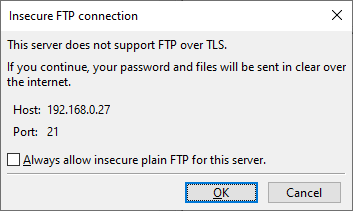
Status: Connecting to 192.168.0.27:21...
Status: Connection established, waiting for welcome message...
Status: Insecure server, it does not support FTP over TLS.
Status: Logged in
Status: Retrieving directory listing...
Status: Directory listing of "/" successfulWhat am I doing wrong?
Thanks in advance for any suggestions. -
There is a way to ZOOM in/out ?
Very interesting product to analyse overall of a project! -
Strange you have memory problems in compilation after 300000 lines of code.
I have been compiling projects of almost 20,000,000 lines of code for years on a PC with 16GB of RAM without such problems.
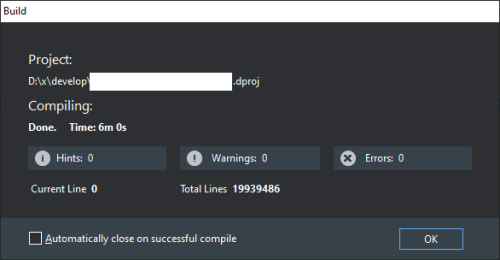
Unfortunately, our software products are almost always free and related to the sale of cheap hardware so for the timebeing we have stopped at Sydney UP1 and so I don't know if the error problems with out of memory depend on the version....
What I don't like about the system is that anyway as soon as a new version comes out there are no more patches for the most important stability bugs in the IDE and language server system....
-
misunderstand question sorry (removed reply contents)
-
IMO: Since my first Python code I've used many Python IDEs: Thonny, Visual Studio and Visual Studio Code, IntelliJ for Python, etc, etc but PyScripter is a step ahead and my preferred.
Congrats on your efforts pyscripter. -
1 hour ago, dummzeuch said:Wikipedia says otherwise:
https://en.wikipedia.org/wiki/PLY_(file_format)
"There are two versions of the file format, one in ASCII, the other in binary."
You are right ! ... I've missed WIKI 🙂
https://github.com/neurolabusc/plyview/blob/master/mesh.pas
LoadPly procedure for ASCII and BIN-
 1
1
-
-
PLY is "ASCII" if you read the specifications.
Sorry for the previous wrong text... sometimes I write very bad English...
-
GLScene PLY importer is VERY limited and only ASCII.
It reads points for triangles and does not support NORMALS.It is so close to STL format...
Meshlab sources (in C++) can be useful to check how to read it. -
Interesting and disheartening in the same way.
Over the past 7 years, I have created an entire CNC ecosystem from logic boards to CNC control software running on Windows OSdone entirely in Delphi (well it runs without any problem, and in some bought even better, in Linux environment under Wine,
at least as far as memory management is concerned).
For OPC UA server management I have already sketched out something following the OPC 40502 standard (OPC UA for Computerized Numerical Control (CNC) Systems),initially using Python opcua but then switched to a program external to Delphi made with QT.
Not having native handling in Delphi makes things quite complex for me, and I have to do everything with an additional TCP layer between the two processes to exchange information, events, etc.
I am precisely looking for a way to avoid all this and keep everything in one language and process. -
Hi all.
I need to implement an OPC UA Server in a Delphi program.Actually, I've used an external QT C++ application to do OPC UA things but is complex to
maintain changes in the server and share an interface between this external program and the main program written with Delphi
and I would like to know if there is a valid native Delphi library to use, better if open-source, but this is not mandatory.
Thank you for your suggestions.
-
In this case, a "key":@method hash list (GpStringHash from Primoz Gabrijelcic) could be a practicable solution ?
I've used often...-
 2
2
-
-
Sincerely 'automate' term without explanation can mean all and nothing...
If you mean to automate the test of a program you can check:https://smartbear.com/blog/automatedqa-is-now-smartbear-software
-
13 minutes ago, mvanrijnen said:8 minutes ago, mvanrijnen said:Just a quick question is the 16Mb limit still valid for the tool?
I'm not an expert with PDB but that is what I've done and now seems to work:
- Installed the latest version of VTune Profiler (2023.1.0).
- Changed the original amplxe_media140.dll with an old version from Jan Rysavy (previous posts).
- Enabled map in Detailed mode.
- Compiled a project of 1.359.947 code lines (including library sources) which generate a map file of 49.696.190 bytes.
- Executed map2pdb.exe rosettacncpph1.64.map -bind -vD:\x\develop\qem\rosetta_cnc_1>map2pdb.exe rosettacncpph1.64.map -bind -v map2pdb - Copyright (c) 2021 Anders Melander Version 2.8.0 Constructed a new PDB GUID: {F2D8CB4B-DA08-4BBD-A399-DBC449AF1364} Output filename not specified. Defaulting to rosettacncpph1.64.pdb Reading MAP file - Segments - Modules - Symbols Warning: [116390] Failed to resolve symbol to module: [0004:00000000000002C8] SysInit.TlsLast Warning: [116392] Failed to resolve symbol to module: [0003:00000000FE7F6000] SysInit.__ImageBase - Line numbers Collected 3.996 modules, 182.925 symbols, 525.223 lines, 985 source files Constructing PDB file - Collecting source file names - Module streams - Strings stream - PDB Info stream - TPI stream - Symbols stream - DBI stream - IPI stream - Finalizing PDB file - 9.068 blocks written in 3 intervals PE filename not specified. Defaulting to rosettacncpph1.64.exe Patching PE file - PE32+ image (64-bit) - Adding .debug section. - PDB file name has been stored in debug data. - PE file has been updated. Elapsed time: 00:00:00.895This has generated a PDB file of 37.142.528 bytes
- Started profiling of EXE in VTune profiler which generates this log at the profiling stop:
Data collection is completed successfully May 22 2023 18:06:59 The result file 'XXX\r001hs\r001hs.vtune' is successfully created and added to the project . Finalization completed with warnings May 22 2023 18:08:33 Result finalization has completed with warnings that may affect the representation of the analysis data. Please see details below. Cannot locate debugging information for file `C:\WINDOWS\System32\msvcrt.dll'. Cannot locate debugging information for file `C:\WINDOWS\WinSxS\amd64_microsoft.windows.common-controls_6595b64144ccf1df_6.0.19041.1110_none_60b5254171f9507e\COMCTL32.dll'. Cannot locate debugging information for file `C:\WINDOWS\WinSxS\amd64_microsoft.windows.gdiplus_6595b64144ccf1df_1.1.19041.2251_none_91a40448cc8846c1\gdiplus.dll'. Cannot locate debugging information for file `C:\WINDOWS\SYSTEM32\ntdll.dll'. Cannot locate debugging information for file `C:\WINDOWS\System32\GDI32.dll'. Cannot locate debugging information for file `C:\WINDOWS\System32\SETUPAPI.DLL'. Cannot locate debugging information for file `C:\WINDOWS\System32\KERNEL32.DLL'. Cannot locate debugging information for file `C:\WINDOWS\System32\cfgmgr32.dll'. Cannot locate debugging information for file `C:\WINDOWS\System32\gdi32full.dll'. Cannot locate debugging information for file `C:\Program Files\Bitdefender\Endpoint Security\bdhkm\dlls_266262988153465131\bdhkm64.dll'. Cannot locate debugging information for file `C:\WINDOWS\System32\user32.dll'. Cannot locate debugging information for file `C:\WINDOWS\System32\combase.dll'. Cannot locate debugging information for file `C:\Program Files\Bitdefender\Endpoint Security\atcuf\dlls_266575548366517634\atcuf64.dll'. Cannot locate debugging information for file `C:\WINDOWS\system32\mswsock.dll'. Cannot locate debugging information for file `C:\WINDOWS\system32\uxtheme.dll'. Cannot locate debugging information for file `C:\WINDOWS\System32\ole32.dll'. Cannot locate debugging information for file `C:\WINDOWS\SYSTEM32\opengl32.dll'. Cannot locate debugging information for file `C:\WINDOWS\SYSTEM32\DEVOBJ.dll'. Cannot locate debugging information for file `C:\WINDOWS\System32\KERNELBASE.dll'. Cannot locate debugging information for file `C:\WINDOWS\SYSTEM32\TextShaping.dll'. Cannot locate debugging information for file `C:\Windows\System32\msxml6.dll'. Cannot locate debugging information for file `C:\WINDOWS\System32\WS2_32.dll'. Cannot locate debugging information for file `C:\WINDOWS\System32\DriverStore\FileRepository\nv_dispi.inf_amd64_c1a085cc86772d3f\nvoglv64.dll'. Cannot locate debugging information for file `C:\WINDOWS\SYSTEM32\HID.DLL'. Cannot locate debugging information for file `C:\WINDOWS\System32\win32u.dll'. Cannot locate debugging information for file `C:\Program Files (x86)\Intel\oneAPI\vtune\latest\bin64\tpsstool.dll'.:
And all symbols project symbols are visible (not for below list of DLL):
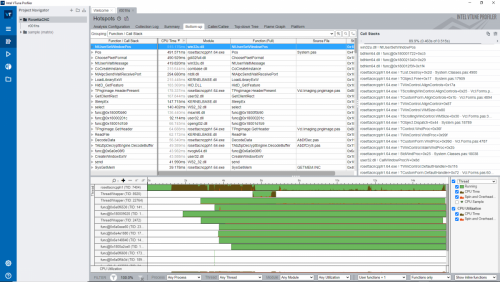
-
-
2 hours ago, Jan Rysavy said:I can confirm replacing C:\Program Files (x86)\Intel\oneAPI\vtune\2023.1.0\bin64\amplxe_msdia140.dll (version 14.34.31942.0) with version 14.28.29910.0 from VTune 2022.4.1 solves this problem!
Can you attach the working DLL to try ?
-
9 minutes ago, Jan Rysavy said:I just want to add that I installed an older version of VTune 2022.4.1 and the function names are displayed correctly. The problem seems to be related to the new version VTune 2023.1.
I've tried to find a way to download the older version (2022.4.1) but no way found on the intel VTune pages....
-
Incredible tool, congrats.
I've tried to use it with Sydney 10.4.1 and VTune 2023.1.0.
Unfortunately, I was not able to get the function as name, I get only func addresses:
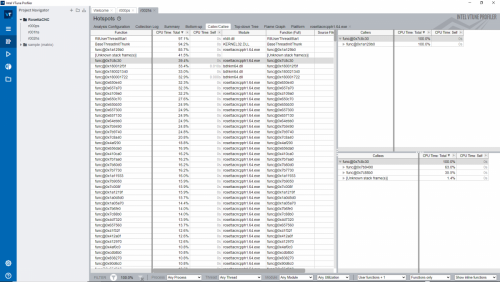
I've tried with:
D:\x\develop\qem\rosetta_cnc_1>map2pdb.exe rosettacncpph1.64.map -bind map2pdb - Copyright (c) 2021 Anders Melander Version 2.8.0
and also with:
D:\x\develop\qem\rosetta_cnc_1>map2pdb.exe -bind rosettacncpph1.64.map map2pdb - Copyright (c) 2021 Anders Melander Version 2.8.0
Map is set to Detailed on Sydney 10.4.1:
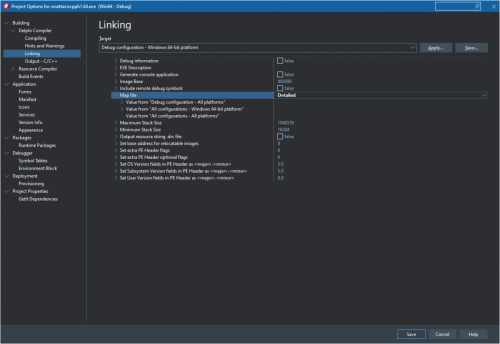
D:\x\develop\qem\rosetta_cnc_1>map2pdb.exe rosettacncpph1.64.map -bind -v map2pdb - Copyright (c) 2021 Anders Melander Version 2.8.0 Constructed a new PDB GUID: {5D8591F1-8F38-4E7B-BAE4-1BB55536733F} Output filename not specified. Defaulting to rosettacncpph1.64.pdb Reading MAP file - Segments - Modules - Symbols Warning: [116390] Failed to resolve symbol to module: [0004:00000000000002C8] SysInit.TlsLast Warning: [116392] Failed to resolve symbol to module: [0003:00000000FE7F6000] SysInit.__ImageBase - Line numbers Collected 3.996 modules, 182.925 symbols, 525.223 lines, 985 source files Constructing PDB file - Collecting source file names - Module streams - Strings stream - PDB Info stream - TPI stream - Symbols stream - DBI stream - IPI stream - Finalizing PDB file - 9.068 blocks written in 3 intervals PE filename not specified. Defaulting to rosettacncpph1.64.exe Patching PE file - PE32+ image (64-bit) - Adding .debug section. - PDB file name has been stored in debug data. - PE file has been updated. Elapsed time: 00:00:00.874I hope you have a simple solution to my possible mistakes.
![Delphi-PRAXiS [en]](https://en.delphipraxis.net/uploads/monthly_2018_12/logo.png.be76d93fcd709295cb24de51900e5888.png)


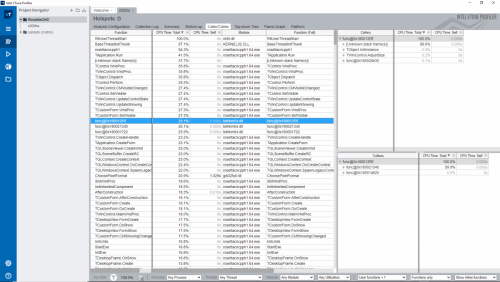
DelphiVCL and asyncio
in Python4Delphi
Posted
In the first experiment, I tried to attach a method to the Application.OnIdle but, visible onto dir(Application) Python notice that is not published.
What is the right python4delphi repo from https://github.com/Embarcadero/python4delphi and https://github.com/pyscripter/python4delphi ?
Sincerely I don't know what to prefer and there are enought of differences between them.